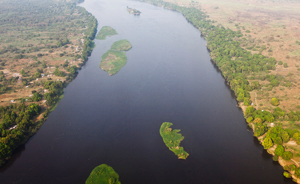
By Ardenia Jones Terry
Egypt is the land of pharaohs, the cradle of civilization and an African country. Egypt is part of the motherland and as African Americans you are at home on Egypt’s soil. The recent uprisings in Egypt have subsided and with the return to normalcy, tourism will rebound. For Egypt is one of the most tourist-driven countries in the world. When tourism returns, book your tour for you will want to see awe-inspiring Egypt-the magnificent.
There are 75 million+ Egyptians living close to the Nile waiting for you to visit. “Must see” sights provide ancient history, intriguing places, mysterious temples, and cultural experiences.
I traveled to Egypt with a group of African Americans from around the United States. It was a trip of a lifetime. For I found that if you are looking for an enchanting fusion of the old world and the modern world, look no further than Egypt.
Cecil C. Smith of Toledo, Ohio, a member of the group that traveled to Egypt said, “You cannot go to Egypt without seeing the pyramids and the Sphinx or leave without seeing the Cairo Museum which has the largest collection of mummies in the world. I was also impressed with the Valley of the Kings. You must go into the Tomb of King Tut and the Tomb of Ramses IV with the vibrant colors, hieroglyphics, and sarcophagi.”
Several of the amazing highlights and “must sees” from the trip to Egypt are:
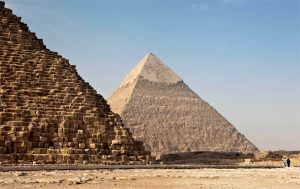 The Pyramids of Giza (Cairo)
The Pyramids of Giza (Cairo)
The Pyramids of Giza represent one of the greatest architectural sites made by man. The last surviving member of the original Seven Wonders of the World, the Great Pyramids of Giza are one of the oldest tourist attractions and the reason most people visit Egypt today.
Often pictured as being in the desert, the Pyramids of Giza are located in the urban area of Cairo surrounded by residential and commercial buildings. There are three main Pyramids in Giza, the Great Pyramid of Khufu ( or Cheops), the Pyramid of Khafre and the smaller Pyramid of Menkaure.
There are narrow entrances to the three pyramids which enable you to see firsthand the massive slabs of limestone and granite that were used to construct the pyramids. The question people most often contemplate when viewing the pyramids is how did the Egyptians build these pyramids?
Of all the Wonders of the World, there really is no other Wonder like them. The Pyramids of Giza have all other destinations in the world beat.
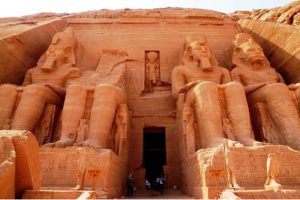 The Sphinx (Giza/Cairo)
The Sphinx (Giza/Cairo)
In front of the Giza Pyramids lies the Sphinx. The Sphinx was named from its similarity to a mythical Greek creature with a lion’s body and a woman’s head. The construction of the Sphinx remains unknown. Tourists view the Sphinx from a viewing platform and from the platform, it appears as if you could reach out and touch the Sphinx’s head although policy does not allow visitors to touch the Sphinx.
Solar Boat Museum (Cairo)
After viewing the Pyramids, visit the Solar Boat Museum which is located next to the Pyramids of Giza. The solar boat was built for Pharaoh Khufu and was intended to be the boat he would use in the afterlife. Built 4500 years ago, extraordinarily, there are no nails in the boat. The boat is held together with special grass ropes that shrink when they become wet.
The grass ropes once wet then pull the cedar boards of the boat together making a water-tight seal. Brilliant. This historic relic was unbelievable for it was built without modern machinery.
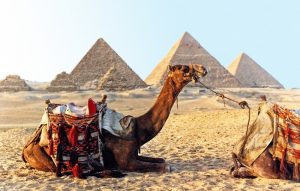 The Egyptian Museum (Cairo)
The Egyptian Museum (Cairo)
Usually, the first stop people make when traveling to Egypt is to the Egyptian Museum and rightfully so. You will not be disappointed with the museum. The museum houses artifacts and displays that portray ancient Egypt. You can see mummies of Egypt’s Pharaohs preserved for thousands of years, sarcophagi, and King Tutankhamen’s treasures. King Tut’s treasurers were fascinating and a must see. The treasures include such objects as his golden jewel chest, wooden statues of King Tut, a golden Ankh, rings, bracelets, sandals, Golden Viscera Coffin, Gold Throne, Gold Ecclesiastical Throne and the solid gold funeral mask.
Alabaster Mosque/Mosque of Mohammad Ali) Cairo
The Alabaster Mosque (Mosque of Mohammad Ali) is a grand structure located atop the highest point in The Citadel of Saladin. The mosque is named after the Ottoman ruler Mohammad Ali who laid the foundation for the modern nation of Egypt. It is also called the Alabaster Mosque because of the alabaster stone that was brought in to cover the exterior walls. It was built between 1830 and 1848.
Due to its size and Ottoman style, the mosque may be seen all over Cairo from various advantage points. The domes of the mosque appear to glisten in the sunlight. As a result of its grandeur, our group picture was taken on the grounds with the mosque in the background. Your trip to Cairo will not be complete without seeing this mosque.
Step Pyramid/Pyramid of Djoser (Sakkara/Saqqara)
The Step Pyramid was Egypt’s first pyramid. The earliest Egyptian pyramids were all step pyramids. The architect Imhotep built Egypt’s first step pyramid, the Pyramid of Djoser, known as the “true pyramid.” The Pyramid of Djoser (Zoser) was built during the 27th Century BCE. The Djoser Step Pyramid is astounding to see and similar in form to the Chichen Itza Pyramid in Mexico.
Statue of Ramses II & the Alabaster Sphinx (Memphis)
Memphis was the capital of the Old Egyptian Kingdom. In Memphis, the group viewed the gigantic statue of Ramses II which remains in the same place it was discovered. The grand size of the statue makes ordinary people standing beside it look like miniature people or ants. This enormous statue of Ramses II is sheltered in pavilion which allows visitors better viewing. The last remaining Alabaster Sphinx was also found amongst the ruins of the Memphis Temple.
The Nubians (Aswan)
When we arrived in the Aswan Airport, a young Nubian man in his 20’s looked at members in the group with darker hues and said, “Nubian” and I smiled. Later that day while on an Aswan City tour, an elderly Nubian man dressed in traditional African clothes looked up as I passed him and said, “Nubian” and I replied, “Yes, I am.”
The Nubians are a group originally from northern Sudan and southern Egypt. In ancient times, Nubians were depicted by Egyptians as having darker skin. The Greeks described them as “the people of the burnt faces.” Ancient Nubians were famous for their wealth, their trade, their skill and precision with the bow, their 23-letter alphabet and boatmanship. Nubians were the early rulers and pharaohs of Egypt.
Nubia was the source of gold for the region. When the Aswan High Dam was constructed in the 1960s, much of Nubia was flooded, destroying archaeological sites and displacing most Egyptian Nubians
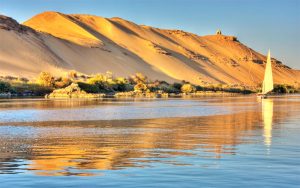 Nile River Cruise-The Temples (Aswan, Kom Ombo, Luxor)
Nile River Cruise-The Temples (Aswan, Kom Ombo, Luxor)
Travel on the world’s most well-known river up the Nile to explore the ancient temples. There are a number of ancient temples to visit in Egypt. You can see most of these on a Nile Cruise which the group took. Here are a few of the most famous ones to see: Deir el Bahri (Luxor)-The temple of the female pharaoh, Queen Hatshepsut. Luxor (Luxor)- A spectacular temple built largely by Amenhotep III and Ramses II around 1400 BC. Its main purpose was to celebrate the festival of Opet. It was a place of worship for Christians and later Muslims. Kom Ombo (Luxor)-This is a miraculously preserved temple dedicated to the crocodile god Sobek. Isis-Philae (Aswan)-The Temple of Isis is the largest structure on the island of Agilkia, accessible by boat. Karnak (Luxor)- The temple isan enclosure containing a vast collection temples, halls, statues and a number of temples. Horus ( Edfu)-The last big temple to be built in 237 B.C. and finished a 140 years later. The interior walls are covered in reliefs that tell the story of the birth of Horus and picture the rulers of the country making offerings to the gods.
The Valley of the Kings (Luxor)
The Valley of the Kings is another well-known archaeological site. This historic landmark is where most of the Egyptian Kings or pharaohs were buried. As you approach the valley, it looks desolate, barren, and uninhabitable, exactly as the Egyptian rulers wanted it to appear. For the rulers did not want people to find the tombs.
The tombs tourists have access to are the Tomb of Tutankhamen, Tomb of Memeptah, and the Tomb of Ramses IV which I personally explored and was fascinated with the detailed hieroglyphics on the tomb walls. The preservation of the tombs was stunning, an absolute must see.
Valley of the Queens (Luxor)
If you see the Valley of the Kings, you must visit the Valley of the Queens. The Valley of the Queens was the resting place of the queens, princesses and other royal women. In the Valley of the Queens, the group viewed the recently renovated Temple of Queen Hatshepsut (Deir el Bahri). The works represented at the tomb were beyond amazing.
The Temple of Queen Hatshepsut is dedicated to the Sun God. Queen Hatshepsut was regarded as one of the most successful pharaohs. On site sculptures inside the tomb depict the history of the first female pharaoh which is often thought to be Queen Hatshepsut but Egyptian history documented other women pharaohs before her.
The Tomb of Queen Nefertari is also open for viewing. Colossi of Memnon (Luxor) The Colossi of Memnon is a couple of stone statues weighing 700 tons each created sometime in the 14th Century. The statues are all that remain of the Temple of Amenhotep III. The statues, es-Salamat and elColossat are in seated positions facing visitors as they approach. The sheer enormity of the statues is hard to believe unless you see them.
Every Day Egyptian Life
Many travelers to Egypt find that in addition to the ancient sites, “must sees” exist in every day Egyptian life. Carolyn Smith, of Toledo, Ohio, one of the travelers in the group, indicated there were additional “must sees” beyond the historical sites. She stated “the traffic on the highways was something to see with donkeys, camels, and horses meandering on the highway alongside automobiles, buses, bicycles, and flatbed trucks. The flatbed trucks were crowded with Egyptians getting on and off the trucks as they proceeded down the highway. The traffic seemed chaotic but orderly at the same time.”
Also, to her: “all the different women were a must see. The women were wearing a variety of clothing, some were wearing traditional Muslim clothing and some women were wearing western clothes. You saw many bright, bold, multicolored garments as well as the traditional black garments. Some women’s faces were covered with berqas, other women’s face were not covered. Some women wore head coverings/scarves (hijabs), others did not. Many women wore make-up and Henna paintings. The Egyptian women were not monolithic. Their approach to life varied just like women from other parts of the world.”
A trip to Egypt would not be complete unless you experience the following: -Take a three or four day Nile Cruise; Ride a camel to the Pyramids of Giza; Attend the Pyramids of Giza light show at night then walk a half block to the Hard Rock Café and purchase a t-shirt; Visit a carpet school where students learn to make rugs and carpets and sell them; Have dinner at a restaurant overlooking the Pyramids of Giza, and/or -Purchase a cartouche, perfume oil, or papyrus paper.
As African Americans, the group was often greeted by Egyptians as “cousins” or they would call out “Obama” to us. It was humorous but also a piece of home. Go home…See amazing Egypt …you will not regret it.
Ardenia Jones Terry, Ph.D., is a former associate vice president of Student Life at The University of Toledo

